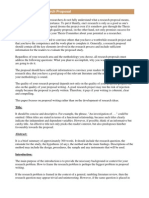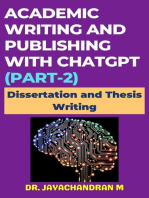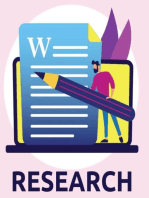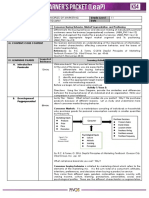0 ratings0% found this document useful (0 votes)
14 viewsGuidance On Research Proposal
Guidance On Research Proposal
Uploaded by
Phước LêThis document provides guidance for writing a research proposal, including sections that should be included such as title, aims/questions, background/purpose, literature review, methodology, methods, and project plan. The proposal should be 2000 words maximum and provide a concise outline of the rationale, research questions, methodology, and methods for the dissertation research. Key elements that must be addressed are the research problem/topic, a review of relevant literature to justify the study, choice of methodology and specific research methods aligned with the questions/aims, and a feasible project plan and timeline. References must be in APA format. While the proposal provides direction, the researcher may need to make adjustments as the project develops.
Copyright:
© All Rights Reserved
Available Formats
Download as DOCX, PDF, TXT or read online from Scribd
Guidance On Research Proposal
Guidance On Research Proposal
Uploaded by
Phước Lê0 ratings0% found this document useful (0 votes)
14 views3 pagesThis document provides guidance for writing a research proposal, including sections that should be included such as title, aims/questions, background/purpose, literature review, methodology, methods, and project plan. The proposal should be 2000 words maximum and provide a concise outline of the rationale, research questions, methodology, and methods for the dissertation research. Key elements that must be addressed are the research problem/topic, a review of relevant literature to justify the study, choice of methodology and specific research methods aligned with the questions/aims, and a feasible project plan and timeline. References must be in APA format. While the proposal provides direction, the researcher may need to make adjustments as the project develops.
Original Title
Guidance-on-Research-Proposal
Copyright
© © All Rights Reserved
Available Formats
DOCX, PDF, TXT or read online from Scribd
Share this document
Did you find this document useful?
Is this content inappropriate?
This document provides guidance for writing a research proposal, including sections that should be included such as title, aims/questions, background/purpose, literature review, methodology, methods, and project plan. The proposal should be 2000 words maximum and provide a concise outline of the rationale, research questions, methodology, and methods for the dissertation research. Key elements that must be addressed are the research problem/topic, a review of relevant literature to justify the study, choice of methodology and specific research methods aligned with the questions/aims, and a feasible project plan and timeline. References must be in APA format. While the proposal provides direction, the researcher may need to make adjustments as the project develops.
Copyright:
© All Rights Reserved
Available Formats
Download as DOCX, PDF, TXT or read online from Scribd
Download as docx, pdf, or txt
0 ratings0% found this document useful (0 votes)
14 views3 pagesGuidance On Research Proposal
Guidance On Research Proposal
Uploaded by
Phước LêThis document provides guidance for writing a research proposal, including sections that should be included such as title, aims/questions, background/purpose, literature review, methodology, methods, and project plan. The proposal should be 2000 words maximum and provide a concise outline of the rationale, research questions, methodology, and methods for the dissertation research. Key elements that must be addressed are the research problem/topic, a review of relevant literature to justify the study, choice of methodology and specific research methods aligned with the questions/aims, and a feasible project plan and timeline. References must be in APA format. While the proposal provides direction, the researcher may need to make adjustments as the project develops.
Copyright:
© All Rights Reserved
Available Formats
Download as DOCX, PDF, TXT or read online from Scribd
Download as docx, pdf, or txt
You are on page 1of 3
Lưu ý: mục cần làm đã bôi vàng. Các phần còn lại là hướng dẫn và quy đinh.
Deadline 26/11/2022 - 04/12/2022.
Research Proposal Guidance
Overview
The Proposal will provide a brief outline of the rationale, focus, research questions, and selection of
methodology and methods for the Dissertation.
Title
The title of the project should accurately reflect the nature of the proposed research. However, this
is a working title which may need to change later on. The title should be under 15 words in total.
Aims/questions
List the main aims of the research as bullet points. These signal your intent in doing the research.
Aims should be few, 3 or 4 at most – a greater number suggests that you are proposing more than
can be done in just one project. Make sure the aims are tightly focused, and cover the main aspects
of the research. For example, one aim might be to map or scope the current situation in your
research field. Another might be to deepen understanding of particular experiences or practices in
your field. A third might be to inform others (e.g. policymakers, practitioners, students, parents etc.)
about this. A fourth might be to apply a particular theory to understand your topic. It is always
useful to have a theoretical aim, as this indicates the masters potential of your research The aims
given here are suggestions for possible types of aims, not a prescription.
Avoid using verbs like ‘to explore’, ‘to examine’, ‘to investigate’ in your aims – these are broad
processes, not specific intents. It is better to use verbs such as ‘to map’, ‘to identify’, ‘to determine’,
‘to inform’ etc.
Also avoid aims such as ‘to deepen understanding of non-traditional students’ experiences’, which
are vague - students have many different experiences in their lives! Specify which particular
experiences you are trying to understand, e.g. ‘non-traditional students’ experiences of teaching and
learning in higher education’, or ‘non-traditional students’ experiences of balancing higher
education with the demands of family life’.
Research questions should be as precise as possible given the anticipated methodology – e.g.
ethnographic research will usually have considerably more open aims and objectives which will
evolve as the researcher engages over time with the field, whilst other approaches may demand very
specific research questions or even hypotheses.
Background and purpose
Begin the main body of the proposal with a paragraph that gives a clear and succinct statement of
the background and purpose of the research. It should highlight an area/problem of importance to
the field, briefly outline its context.
Reviewing the literature to make the case for your research
In this section you will make the case for the study: review key empirical findings and theoretical
positions and debates already established in the literature (this will need to be developed throughout
the project, but the most important authors and texts should be reflected at this stage). Identify both
what is already known, and how your research fits with what is already known. Your aim is to
outline the main ideas that have shaped your proposal and to show that you have an understanding
of similar work and how it relates to your proposal. Show you understand conceptual/theoretical
differences in the literature, and define key concepts being used. This section should be written so
as to justify the proposed study: it therefore has to be succinct and very focused. A strong personal
interest in a particular issue may be necessary, but on its own it is not sufficient justification for
carrying out research. This section needs to be argued in a coherent manner, and supported by
citations to the literature. You may find it helpful to structure this section around a small number of
themes (eg historical perspectives, key debates, theoretical perspective, policy context etc).
Methodology
Explain the methodology chosen and why it appears the most appropriate one to generate the data
that will provide answers to the research questions/meet the research aims. Denscombe (2017)
outlines seven strategies, which may be a useful overview from which to select ONE that will be
appropriate for your research design.
Methods (research design)
Outline the specific methods which you intend to use (again, this may have to shift as the research
progresses, and is not ‘written in stone’). This must be justified, again with reference to the research
questions/objectives. It must also be appropriate to the overall methodology. The design should be
as explicit as possible, recognising that in some approaches the methods cannot be as pre-defined as
in others. But provide as much detail as you can about what you intend to do, and where methods
cannot be pre-defined, show what you intend to do to in order to define them at a later stage. It is
very helpful to cross-reference each different element of the research design to the relevant
numbered research questions/objectives to show that you have chosen methods appropriate to
answering the m.
The design should be clearly feasible for the scale of project with the limited time and other
resources available to the you. This means that, for example, a proposal for a study based on
interviews should state clearly how many interviews you aim to do, and how long they will be. The
key is that the proposal should enable you to get sufficient data that is appropriate to answer the
research questions. So the quality of the data, its richness and depth is generally going to be more
helpful than lots of very bland predictable and repetitive data. So 8 one-off interviews of 30 minutes
may be appropriate for an institutional case study. Just one or more participants may be enough for
a narrative life history project with several interviews of up to 2 hours each. You might also be
using mixed methods with questionnaires for breadth and interviews for depth and here fewer
interviews would be needed. It is often helpful to think of naturally occurring data that is collected
as part of your work role (e.g students’ work, assessment data, minutes of meeting, classroom
observation etc)
You will also need to cover issues like sampling, instruments (will you use questionnaires,
structured/semi-structured/unstructured interviews and/or observations, concept mapping etc. etc.),
data collection method (face-to-face, telephone, focus groups etc), access, transcription.
Consider the limitations of your methods and how you will plan to minimise these for example
questionnaires have generally a low return rate and give superficial data, how can these problems be
avoided? How can the subjectivities associated with action research be acknowledged and the
validity of the approach strengthened? Convey an in depth understanding of how you will be able to
justify the quality of your data gathering through wider reading about methodology and methods.
Project plan
A useful end point is to show the planning and timescale of the project e.g. in a Gantt chart or table
or excel file. This should address the different stages of the project, from start to submission, and
show an awareness that some stages are on-going or repeated and will overlap with others. Again,
realistic project management and feasibility need to be shown here.
Writing the proposal and references
The proposal should be written in clear and correct English, and in an academic style. Make sure
you support your arguments and avoid plagiarism by citing other authors, and include a full list of
references for all of your citations at the end. References must be given using APA 7th format.
Length of proposal
A word length is 2000 (the list of references should not be included in this word count). Part of the
discipline of the research proposal is to hone the piece very tightly and clearly, and avoid ‘waffle’.
Format and submission process
The submission will be uploaded to Brightspace as a SINGLE file in any format (eg MS Word,
WordPerfect, PostScript, PDF, HTML, RTF, OpenOffice (ODT) and plain text formats).
And finally…
Your proposal is a ‘springboard’ for your project, and needs to give you a clear and manageable
sense of what you are setting out to do. Be aware, though, that a researcher often needs to introduce
creative change as their research develops: the proposal should not be seen as ‘written in stone’ for
the duration. Research questions may need to be adjusted, new issues may arise.
You might also like
- Research Proposal: Academic Writing Guide for Graduate StudentsFrom EverandResearch Proposal: Academic Writing Guide for Graduate StudentsRating: 4.5 out of 5 stars4.5/5 (42)
- PHD Thesis Proposal in ArchitectureDocument5 pagesPHD Thesis Proposal in ArchitectureHelpOnWritingAPaperAlbuquerque100% (2)
- How To Write A Research ProposalDocument7 pagesHow To Write A Research ProposalMalik SaimaNo ratings yet
- Koforidua Polytechnic Department of Applied Mathematics Final Year Project Work GuideDocument6 pagesKoforidua Polytechnic Department of Applied Mathematics Final Year Project Work GuideEdwin Okoampa Boadu0% (1)
- How To Write A Project ProposalDocument3 pagesHow To Write A Project ProposalChuka Dennis OffodumNo ratings yet
- A Guide For A Full Time PHDDocument3 pagesA Guide For A Full Time PHDYogi ChaudharyNo ratings yet
- How To Write A Research ProposalDocument4 pagesHow To Write A Research Proposaljaved765No ratings yet
- How To Write A Research Proposal PDFDocument3 pagesHow To Write A Research Proposal PDFMariglen DemiriNo ratings yet
- A GUIDE FOR A FULL TIME PHD PROPOSALDocument4 pagesA GUIDE FOR A FULL TIME PHD PROPOSALOkunola Wollex100% (1)
- Research Prop Guide 2014Document4 pagesResearch Prop Guide 2014amani mahiNo ratings yet
- How To Write A Research ProposalDocument2 pagesHow To Write A Research Proposalamit chavanNo ratings yet
- Thesis Proposal TipsDocument5 pagesThesis Proposal TipslublinerNo ratings yet
- How To Write A Research ProposalDocument4 pagesHow To Write A Research Proposalnaitikooo70% (1)
- How To Write A Research Proposal : GrantDocument14 pagesHow To Write A Research Proposal : GrantWendi WilliamsNo ratings yet
- Chapter 3 Writing Research Proposal Edited 2007Document12 pagesChapter 3 Writing Research Proposal Edited 2007abibual100% (1)
- Guideline Research Proposal PDFDocument2 pagesGuideline Research Proposal PDFManoj SubramaniNo ratings yet
- How To Write A Research ProposalDocument4 pagesHow To Write A Research ProposalOmer UsmanNo ratings yet
- Lecture 6, Research Workshop 1Document5 pagesLecture 6, Research Workshop 1Qasim AliNo ratings yet
- General Information:: Title PageDocument3 pagesGeneral Information:: Title PageUsman SheikhNo ratings yet
- Chapter 9 - Writing A Research Proposal - 1Document29 pagesChapter 9 - Writing A Research Proposal - 1Linh Nguyễn PhươngNo ratings yet
- Research Proposal GuidelinesDocument5 pagesResearch Proposal GuidelinesEdward paulNo ratings yet
- PhDProposal GuideandSamples OnlineDocument5 pagesPhDProposal GuideandSamples OnlineAssad Azeem100% (1)
- Writing Up and Presenting Criminological Research: Alexandra Hall, Northumbria UniversityDocument20 pagesWriting Up and Presenting Criminological Research: Alexandra Hall, Northumbria Universitytania ichimNo ratings yet
- Way To Write A Research ProposalDocument5 pagesWay To Write A Research Proposalmahmalrajpot365No ratings yet
- How To Write A Research ProposalDocument4 pagesHow To Write A Research Proposalharsimran_toorNo ratings yet
- How To Write A Reseach PaperDocument5 pagesHow To Write A Reseach Papershahabjani9610No ratings yet
- Purpose of Research ProposalDocument4 pagesPurpose of Research ProposalKashif19869802No ratings yet
- Research - ProposalDocument31 pagesResearch - ProposalEmmanuel Selase Asamoah100% (1)
- PHD Reasearch FormatDocument4 pagesPHD Reasearch FormatwbothaNo ratings yet
- Untitled DocumentDocument16 pagesUntitled DocumentmimiyahhahNo ratings yet
- Research Proposal FormatDocument2 pagesResearch Proposal FormatTịnh Vân PhạmNo ratings yet
- Research: Proposal: Prof. Dr. Md. Ghulam Murtaza Khulna University Khulna, BangladeshDocument31 pagesResearch: Proposal: Prof. Dr. Md. Ghulam Murtaza Khulna University Khulna, BangladeshSaiful Hadi Mastor100% (1)
- Student Research Proposals 2021Document15 pagesStudent Research Proposals 2021TheBoss 20No ratings yet
- Decode Guidelines For Research ProposalsDocument7 pagesDecode Guidelines For Research ProposalsStrawberiey OniiNo ratings yet
- Methods Research ProposalDocument3 pagesMethods Research ProposalMuheed KhanNo ratings yet
- Writing A Good PHD ProposalDocument5 pagesWriting A Good PHD Proposalreddycws5894No ratings yet
- How To Write A Research Project ProposalDocument7 pagesHow To Write A Research Project ProposalNilanjana Chakrabarty100% (1)
- Module 8.research - ReportDocument10 pagesModule 8.research - ReportUmiaziente SuchiNo ratings yet
- L3 ProposalDocument16 pagesL3 ProposalYidnekachwe MekuriaNo ratings yet
- How To Write A Good Research - Proposal-By TSEGAYE S.Document35 pagesHow To Write A Good Research - Proposal-By TSEGAYE S.Milion dugumaNo ratings yet
- How To Write A Research ProposalDocument4 pagesHow To Write A Research Proposaldanilo miguelNo ratings yet
- Research ProposalDocument7 pagesResearch ProposalMahendra ChhetriNo ratings yet
- Senior Research Project FrameworkDocument10 pagesSenior Research Project FrameworkAndualem ZenebeNo ratings yet
- Final Sop of DissertationDocument14 pagesFinal Sop of DissertationPrashant281188No ratings yet
- How To Write A Research Proposal For PHD ThesisDocument7 pagesHow To Write A Research Proposal For PHD ThesisWriteMyPersuasivePaperUK100% (2)
- How To Write A Research DegreeDocument4 pagesHow To Write A Research DegreePrabhat KumarNo ratings yet
- How To Write A Research Proposal: Paul T. P. Wong, PH.D., C.PsychDocument5 pagesHow To Write A Research Proposal: Paul T. P. Wong, PH.D., C.PsychshaniquebinNo ratings yet
- Proposal S3 Di OtagoDocument3 pagesProposal S3 Di OtagoilkomNo ratings yet
- Research - ProposalDocument31 pagesResearch - ProposalGarvit DhingraNo ratings yet
- How To Write A Research ProposalDocument5 pagesHow To Write A Research Proposalhuwaina100% (1)
- SCS PHD Proposal Outline Guidance PDFDocument2 pagesSCS PHD Proposal Outline Guidance PDFNadzimah IdrisNo ratings yet
- Qualitative Research ProposalDocument12 pagesQualitative Research ProposalGerard JohnsonNo ratings yet
- How To Make Setting of The Study in ThesisDocument7 pagesHow To Make Setting of The Study in Thesissheilabrooksvirginiabeach100% (2)
- Thesis Writing Objectives and ApproachesDocument6 pagesThesis Writing Objectives and Approachesgjggsf72100% (2)
- Ahsgs Kol 25012015 Writing An Effective ProposalDocument35 pagesAhsgs Kol 25012015 Writing An Effective ProposalZuridah HanimNo ratings yet
- ChatGPT Guide to Scientific Thesis Writing: AI Research writing assistance for UG, PG, & Ph.d programsFrom EverandChatGPT Guide to Scientific Thesis Writing: AI Research writing assistance for UG, PG, & Ph.d programsRating: 4 out of 5 stars4/5 (1)
- Academic Writing and Publishing with ChatGPT (Part-2): Dissertation and Thesis WritingFrom EverandAcademic Writing and Publishing with ChatGPT (Part-2): Dissertation and Thesis WritingNo ratings yet
- how to write a successful research proposal كيف تكتب مقترح بحث ناجح: a successful research proposalFrom Everandhow to write a successful research proposal كيف تكتب مقترح بحث ناجح: a successful research proposalNo ratings yet
- How to Write a Dissertation: An Instructional Manual for Dissertation Writers.From EverandHow to Write a Dissertation: An Instructional Manual for Dissertation Writers.No ratings yet
- Dughi, 2014Document13 pagesDughi, 2014Daniela Craciun MerindeNo ratings yet
- Growth and Development Across The Life SpanDocument9 pagesGrowth and Development Across The Life SpanNicole Audrey JoaquinNo ratings yet
- Gilovich, Medvec, Chen - 1995 - Commission, Omission, and Dissonance Reduction Coping With Regret in The Monty Hall ProblemDocument9 pagesGilovich, Medvec, Chen - 1995 - Commission, Omission, and Dissonance Reduction Coping With Regret in The Monty Hall ProblemDave SainsburyNo ratings yet
- VENTANA Model PDFDocument1 pageVENTANA Model PDFCristian BerriosNo ratings yet
- Fall 2023 - PSY612 - 8805 - 1Document5 pagesFall 2023 - PSY612 - 8805 - 1Syeda ZainabNo ratings yet
- Quality Improvement Project - AidetDocument7 pagesQuality Improvement Project - AidetAnirban RoyNo ratings yet
- Blooms TaxonomyDocument12 pagesBlooms Taxonomyapi-578090078100% (1)
- Q3 - Principles of Marketing - Week 8Document4 pagesQ3 - Principles of Marketing - Week 8Glaiza PerezNo ratings yet
- Coop Himmelblau. Beyond The BlueDocument8 pagesCoop Himmelblau. Beyond The Blueadela bravoNo ratings yet
- Grade 7 Term 3 Learner - S WorkbookDocument21 pagesGrade 7 Term 3 Learner - S WorkbookBotle MakotanyaneNo ratings yet
- Writing The Discussion Part of A Research PaperDocument11 pagesWriting The Discussion Part of A Research PaperKirsten Claire RomaraogNo ratings yet
- Good Thesis Statement For Rhetorical AnalysisDocument4 pagesGood Thesis Statement For Rhetorical Analysisjmvnqiikd100% (2)
- Principles of Management - (CONTENTS)Document4 pagesPrinciples of Management - (CONTENTS)drhafizaanamNo ratings yet
- CHAPTER 5: Identifying VariablesDocument1 pageCHAPTER 5: Identifying Variablesalia.delareineNo ratings yet
- Elem - Loa - Template-Esp 4 eDocument8 pagesElem - Loa - Template-Esp 4 emarlon novisioNo ratings yet
- Educator Professional Development in Universal Design for Learning and Social-Emotional Learning A Collective Case Study-2023论Document232 pagesEducator Professional Development in Universal Design for Learning and Social-Emotional Learning A Collective Case Study-2023论yil647No ratings yet
- Course Content - Environmental PsychologyDocument4 pagesCourse Content - Environmental PsychologySamuel DareNo ratings yet
- The Eisenstein Universe (Ian Christie and Julia Vassilieva)Document313 pagesThe Eisenstein Universe (Ian Christie and Julia Vassilieva)Peshraw BenNo ratings yet
- The Last LessonDocument5 pagesThe Last LessonAnuradha ChetiaNo ratings yet
- The Power of Emotion (Jun 15)Document2 pagesThe Power of Emotion (Jun 15)AshwinNo ratings yet
- Rocky HorrorDocument9 pagesRocky HorrorJuan Angel CiarloNo ratings yet
- Galatzer Levy 2013 PTSD OPTIONAL PDFDocument12 pagesGalatzer Levy 2013 PTSD OPTIONAL PDFIoana ApetroaeiNo ratings yet
- Attachment ReportDocument10 pagesAttachment ReportAbraham owinoNo ratings yet
- DLL AutomotiveDocument3 pagesDLL AutomotiveSir Joel SalazarNo ratings yet
- Learning DisabilitiesDocument2 pagesLearning DisabilitiesAnbu RajeshNo ratings yet
- Command Terms in Sciences PDFDocument2 pagesCommand Terms in Sciences PDFchethansharmaNo ratings yet
- POS Reflection AssessmentDocument2 pagesPOS Reflection AssessmentBEYZA POYRAZNo ratings yet
- اضطرابات النطق والكلام بحثDocument13 pagesاضطرابات النطق والكلام بحثmannarkhalaf12No ratings yet
- TES - PT Panca Kusuma RayaDocument3 pagesTES - PT Panca Kusuma RayaAngga PradanaNo ratings yet
- Barriers To Business CommunicationDocument22 pagesBarriers To Business Communicationminhalgallian12No ratings yet

























































































